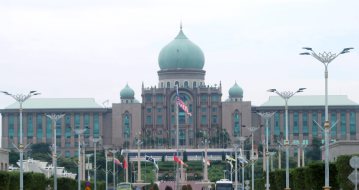Debate on origins of Malays
By - 21 August 2016 @ 1:49 PMTHE origins of the Malays have always generated interest and excitement in popular, academic and policy circles. Over recent decades, the discourse has taken a turn toward Malay origins, ethnicity and identity. Much of it a discourse in deconstruction.
The new media has much induced this with one strand of the debate, dismissing the new theory on Malay origins as false simply because of the allegation that it lacks the rigour of scholarly examination, and has not lent it itself to critical and public debate. The dominant discourse identifies the Malay as a product of centuries of hybridisation, casting doubt on origins of the name “Melayu”, and almost always coming from both the Malays and non-Malays in Malaysia that the ancestors of the Malays have “come from somewhere else” or “have escaped/ran from some place”. “Maleu-kolon” is the first known description of the Malays. This comes from second century Graeco-Egyptian scholar, geographer and map maker Ptolemy.
I am disturbed when the Malays do not know, or have a misplaced view of where they come from. The story of Malay origins and perantauan have not been integral to the nation’s mainstream thought. It is instructive to remind ourselves of several theories as to the origins of the Malays. Briefly there is the so-called Yunnan theory (1889), the Taiwan theory (1997) and the Sundaland theory.
Many still believe that the Malays came from Yunnan. This follows the thinking of Austrian scientist R.H. Geldern, a member of the Vienna School which largely upholds the philosophy of logical positivism, together with the likes of J.H.C. Kern and J.R. Foster, hold the view of the Mekong origin of the Malays. These however are being contested, specifically debunking the Geldern theory of Malay origins. So also Peter Bellwood’s out-of-Taiwan theory (1997). Central to Bellwood’s theory is the concept of Austronesian — the term derives from the Latin auster for south wind and the Greek nȇsos for island. It gives the meaning that the Austronesian family of languages (essentially the Malay languages or Bahasa Melayu serumpun) originated from Taiwan. Some local scholars advocate for the term Austronesian for the family of languages to be replaced by Malayo-Polynesian or Melayunesian (rumpun bahasa Melayunesia in Bahasa Melayu) .
There is a third theory which has debunked the first two theories. This was posited by Professor Stephen Oppenheimer of the School of Anthropology and Museum Archeology of the University of Oxford. Oppenheimer’s work on genetics — specifically in his study of mitochondrial DNA, the genetic material that is passed down through the maternal lineage — has opened up evidence of the peopling of Southeast Asia, specifically the Malay archipelago more than 40,000 years ago. In his 1998 book Eden in the East: The Drowned Continent of Southeast Asia, he proposes the Out of Sundaland theory. According to Oppenheimer, the populations of the north east Asian and the Pacific regions originate from the Southeast Asian subcontinent of Sundaland (Benua Sunda) — rich in culture — that was dispersed when most of Sundaland was submerged.
In a recent lecture titled The Malays: Their Origins, Migration and Travels, Professor Datuk Seri Md Salleh Yaapar of Universiti Sains Malaysia emphasised that the land mass of Sundaland, was already a cradle of civilisation.
But at the last Ice Age, Sundaland was submerged by a catastrophic flood, and due to the rise in sea level, it vanished as the lost Eden (Eden being the biblical name for paradise from the Sumerian edin).
The floods induced mass migrations from Sundaland to areas in the north and east — China, Korea and Japan, as well as the Philippines and Hawaii, Easter Island (or Rapanui) in the east, Madagascar in the west and New Zealand in the South, as well as islands in the southern Pacific.
Salleh, who is also a distinguished fellow at the Centre for Malay World and Islamic Civilisation at the International Islamic University, Malaysia, maintains that the wave of movements to those areas created the early settlers, what we call natives. The rest remained behind. Their experiences are recorded in numerous narratives on floods and migration. These narratives are in turn supported through various disciplines, including physics, genetics, oceanography, linguistics, folklore and anthropology.
Plato’s Atlantis story, the basis of Brazilian nuclear physicist Arysio Nunes dos Santos’ 2005 book titled Atlantis: The Lost Continent Finally Found, the Definitive Localisation of Plato’s Lost Civilisation, declares that Sundaland is the location of the lost Atlantis narrated in Plato’s Timaeus and Critias. Apart from the Ice Age events, dos Santos connects the floods and migration to the volcanic eruptions of Krakatoa and Toba in ancient times. What is significant in Salleh’s argument is that in identifying the origins of ethnicity, apart from genetics, it is also through language as cultural DNA whereby various narratives are told, and orality is processed, refined and linked to history, literature, geography, geology and biology. The field of genomics, it must be emphasised, facilitated and enriched the discourse on Malay identity.
But more important in recent decades is the deconstruction of Malay identity coming from scholars from academic circles within the nation and elsewhere. Some have alleged that Malay ethnicity and identity lack a “core”. Others have asserted that the Malays do not have a history.
Malay ethnicity and identity is not singular. It is not homogenous but multiple. The Malays are a multi-ethnic people, inhabiting Malaysia as a nation-state, the homeland of the Malay archipelago and the Malay world stretching from the Indian to the Pacific Oceans.
The writer, Datuk Dr A Murad Merican, is a professor at the Centre of Policy Research and International Studies (CenPRIS), Universiti Sains Malaysia











